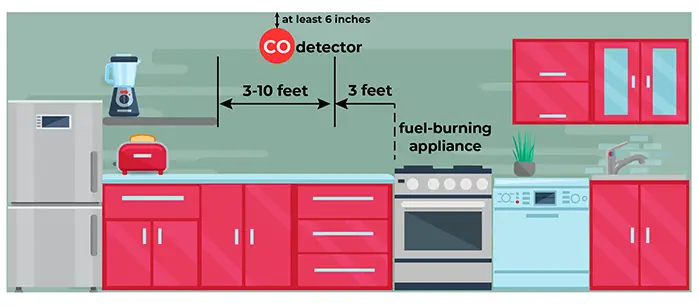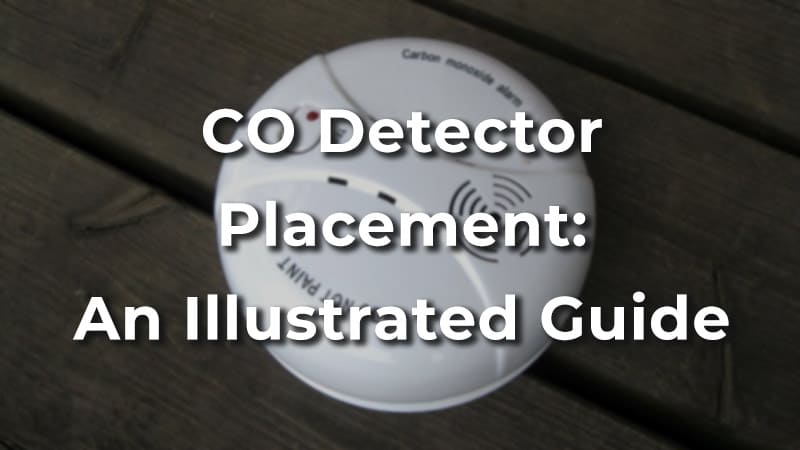Carbon monoxide (CO) detectors are essential safety devices that every home should have: they can potentially save lives in case of an emergency.
Unfortunately, carbon monoxide detectors are often incorrectly installed. While it’s true that having a CO detector in any place is usually better than having none, proper placement is extremely important: you can’t just put it wherever you feel like.
If you really want to enjoy the benefits of early CO detection, you have to find a place where your CO detector works best.
In this article, you’ll find everything you need to know about the proper placement of carbon monoxide detectors, along with some helpful tips to improve safety.
Properties of Carbon Monoxide Gas: Understand the Basics
Although it’s not necessary to know the basic properties of CO gas to find the best place for your detector, I think it can help you understand the potential dangers and the importance of placement.
Carbon monoxide is an odorless, colorless, and tasteless gas, therefore it’s impossible to detect without a proper device (hence the name “silent killer”). Sure, when it accumulates indoors, it can cause symptoms, such as headache, dizziness, or nausea, but those are non-specific and can be easily mistaken for symptoms of food poisoning or flu.
How does carbon monoxide get into the air in your home?

Carbon monoxide gas is produced when fuel (such as oil or gas) is burned improperly by a faulty appliance. This is when carbon monoxide begins to accumulate in indoor air.
The lack of ventilation and fresh air speeds up the process until the point when the high concentration of the gas causes life-threatening health issues that can eventually lead to death. You can check the exact concentrations and symptoms here.
Is carbon monoxide lighter or heavier than air?
Carbon monoxide is slightly lighter than air, however, it is usually distributed evenly in a room. In a study, researchers examined the behavior of CO gas in the air in order to provide suggestions for carbon monoxide detector placement. They’ve found that the levels of CO gas always equalized throughout the test chamber regardless of what height the CO was infused into it.
This means that in most cases CO gas will reach the detector in the room sooner or later regardless of the placement. However, if you want your CO detector to be reliable and alert you as soon as possible, there are some general rules you should keep in mind.
How Carbon Monoxide Detectors Work – Does Placement Affect Their Operation?
The most important component of a carbon monoxide alarm is the sensor: this is the part of the device that actually detects the CO concentration in the room. There are basically three different types of sensors: electrochemical, metal-oxide, and colorimetric.
They all detect CO in a different way, however, the trigger is always the same: elevated CO concentration in the air around the detector. Placement per se does not have a direct impact on the operation of the device, however, positioning can, indeed, affect early detection.
Side note: If you want to delve deeper into the topic of CO sensors, you can find an in-depth article on this website.
The Correct Placement of Carbon Monoxide Detectors
There’s usually quite a bit of confusion when it comes to fitting CO detectors. The good news is that it’s not complicated at all: if you follow a few simple rules, you can find the best places to install your CO detector without much hassle.
Where Should You Place Your Carbon Monoxide Detectors?
- First of all, make sure you place a CO detector in each room that has an open fire or a fuel-burning appliance, such as a heater, gas cooker, furnace, boiler, fireplace, etc.
- Don’t forget about the attached garage: any vehicle with a fueled engine running in a closed space increases the levels of carbon monoxide.
- Also, install CO detectors in every sleeping area and room where people spend the most time, such as the living room.
- Do not skip those rooms that have a flue running through them.
- If you live in a multi-story house, make sure you install CO detectors on every floor (including the basement and attic).
- Don’t forget to check the applicable laws and local codes.

How Many Carbon Monoxide Detectors Do You Need?
Preferably, you should install an approved CO detector in all the rooms listed above. So, basically, the number of CO detectors you need depends on the size of your home and the number of fuel-burning appliances you use.
As a minimum, the National Fire Protection Association (NFPA) recommends that you install CO alarms on every level of your home and in a central location outside each sleeping area and in other locations where required by law and codes.
Carbon monoxide is a toxic gas that you can’t perceive without a device. High levels are potentially lethal and it’s simply not worth risking your and your family’s health and life by not using the right number of CO detectors. Thus, I recommend that you install as many CO detectors as needed to be safe in your home.
This model is my top choice for reliability:
Where to Put a Carbon Monoxide Detector – The Right Mounting Height and Position
- First, check the user manual: if the manufacturer specifies the location and height at which you should place the CO detector, install it accordingly.
- In rooms with a fuel-burning appliance or an open fire, it’s best practice to mount the CO detector on the wall at least 6 inches (about 15 cm) away from the ceiling at a location higher than the height of any window or door, if otherwise not specified in the user manual.
- Also, make sure you do not place a CO detector directly next to a fuel-burning appliance: mount it between 3 feet (about 1 m) and 10 feet (about 3 m) horizontally from the nearest edge of the potential source.
- In rooms without a fuel-burning appliance or an open fire put the CO alarm close to the breathing zone.
- In rooms with sloped ceilings, mount the detector on the high side of the room.

Where Not to Put a CO Detector
- Close to a cooking appliance, water heaters, fireplace, or furnace (never put a CO alarm directly above a source of heat): if you put your CO alarm too close, you might run into false alarms
- Above a sink
- Next to a window or door
- In an enclosed space (in a cabinet or behind curtains, for instance)
- In a place where it can be blocked (by furniture, for instance)
- Dusty places where dirt may obstruct the sensor
- Humid places
- Close to air vents, fans, or other ventilation openings
- Avoid outdoor locations where the recommended operational temperature is not ensured
Note: There are many different types of CO detectors on the market, so make sure you also read and follow the manufacturer’s recommendations.
The video below will give you a general overview of the locations where you should install CO alarms:
Legislation
While it’s true that CO alarms are often required by law, legal requirements are not the same in different states and countries, so you should always contact your local authorities to get up-to-date and complete information.
If you need some general information, you can find some useful material about CO alarm regulations by U.S. states here. If you live in the UK, check out this website.
Useful Tips to Get the Most Out of Your CO Detector
- Test your CO alarms regularly, at least once a month.
- If the CO alarm sounds, open all your windows and doors immediately to let fresh air in, switch off fuel-burning appliances, and leave the building. Do not re-enter the house until the alarm is sounding. Seek medical help if needed.
- Always read the user manual of your CO detector.
- Make sure every family member knows what to do if a CO alarm sounds: pay special attention to kids and seniors.
- Always take a sounding CO alarm seriously.
- Have your fuel-burning appliances and chimney checked by a professional every year.
- Do not use charcoal grills and generators in your garage or home: keep them outdoors, at a safe distance from your windows and doors.
- Do not warm any vehicle with a fueled engine in your garage: always run it in the open air.
- Do not use a gas stove for heating purposes.
Make sure you also check out our best tips to improve home safety here.
Related Questions
How Far Should a Carbon Monoxide Detector Be Placed from a Furnace or Boiler?
Make sure you don’t install any CO detector too close to any appliance that generates heat. Keep at least 12 feet (3.7 m) distance from the furnace or boiler, if otherwise not specified in the user manual. Don’t forget to have your furnace or boiler checked by a professional regularly.
Can You Fit Your CO Detector on the Ceiling?
You can mount your CO detector on the ceiling if the user guide doesn’t say otherwise. However, make sure it’s at least 12 inches (about 30 cm) away from any wall or light fitting.
Carbon Monoxide Detector Placement: Putting It All Together
Like fire extinguishers, carbon monoxide detectors are a must for home safety, no matter where you live. They should be fitted in each room where a fuel-burning appliance operates, near sleeping areas, and on every floor of the building.
Before installing a CO detector, read the manual carefully. If you can’t find any instructions regarding the correct location of the device, mount it at least 6 inches away from the ceiling but higher than the height of the window and door, if possible.
Make sure you don’t place it too close to a fuel-burning appliance: the distance should be between 3 and 10 feet from it. In bedrooms, where there are no fuel-burning devices, it’s best practice to place the CO detector close to the breathing zone.
Avoid not recommended locations, as CO alarms work best if you use them properly and in a proper place. Also, make sure you contact your local authorities if you need specific information.
And finally, don’t forget to test your device regularly to make sure it works properly.
Images: Freepik (Kubanek, Vecteezy, macrovector, studiogstock), Wikimedia












